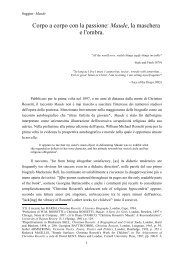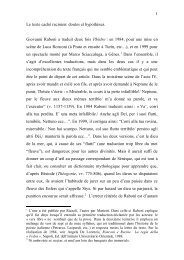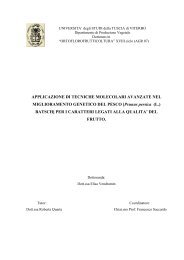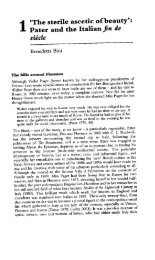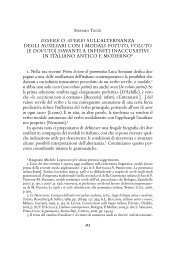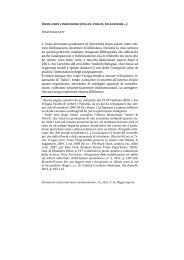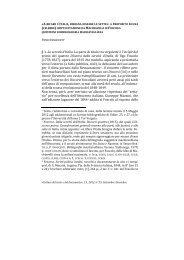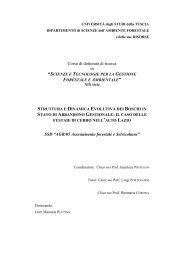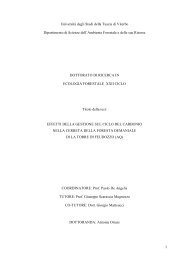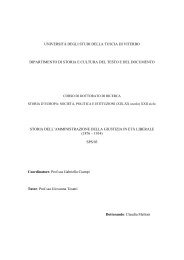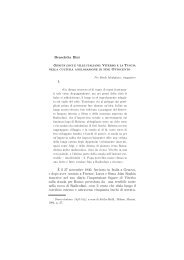drivers of soil respiration of root and microbial ... - Unitus DSpace
drivers of soil respiration of root and microbial ... - Unitus DSpace
drivers of soil respiration of root and microbial ... - Unitus DSpace
Create successful ePaper yourself
Turn your PDF publications into a flip-book with our unique Google optimized e-Paper software.
The estimate <strong>of</strong> <strong>root</strong> <strong>and</strong> <strong>microbial</strong> <strong>respiration</strong> is subjected to additional errors, as the fluxes<br />
are not estimated directly but are calculated from the other measurements, each subjected to its own<br />
errors. We suggest establishing a large amount <strong>of</strong> partitioning plots to minimize the errors in<br />
calculation <strong>of</strong> <strong>soil</strong> <strong>respiration</strong> components.<br />
6.4.2. Combined SIR<br />
Substrate induced <strong>respiration</strong> (SIR) is based on the response <strong>of</strong> <strong>microbial</strong> <strong>respiration</strong> to the<br />
addition <strong>of</strong> glucose <strong>and</strong> the absence <strong>of</strong> response for <strong>root</strong> <strong>respiration</strong> (Panikov et al., 1991).<br />
Combination <strong>of</strong> methods <strong>of</strong> substrate induced <strong>respiration</strong> <strong>and</strong> component integration into one<br />
allowed moving the experiment from the laboratory to the field. The difference in the response <strong>and</strong><br />
comparison <strong>of</strong> CO2 efflux from <strong>soil</strong> with <strong>and</strong> without <strong>root</strong>s before <strong>and</strong> after glucose addition, in the<br />
concentration much lower than the concentrations <strong>of</strong> the soluble carbohydrates in the <strong>root</strong> tissue,<br />
allow calculating <strong>root</strong> <strong>and</strong> <strong>microbial</strong> <strong>respiration</strong> components. After the introduction <strong>of</strong> glucose the<br />
<strong>respiration</strong> <strong>of</strong> microorganisms that was limited in the <strong>soil</strong> with C substrates increases several times<br />
while the <strong>respiration</strong> <strong>of</strong> the living <strong>root</strong>s remains the same. In confront with the other methods used<br />
in this study, combined SIR allows more exact separation <strong>of</strong> actual <strong>root</strong> <strong>respiration</strong>, from all the<br />
other <strong>respiration</strong> sources by accounting a rhizo<strong>microbial</strong> component as a part <strong>of</strong> <strong>microbial</strong><br />
<strong>respiration</strong>.<br />
The applied glucose concentration (3mg/g <strong>of</strong> <strong>soil</strong>) is much lower than the concentration <strong>of</strong><br />
soluble carbohydrates in the <strong>root</strong>s observed for meadow grasses, which ranges from 5 to 50 mg/g <strong>of</strong><br />
<strong>root</strong> depending on the plant species <strong>and</strong> the growing period (Naumov, 1988), so the uptake <strong>of</strong><br />
glucose by <strong>root</strong>s couldn’ t have a significant effect on the <strong>respiration</strong> <strong>of</strong> the living <strong>root</strong>s.<br />
Microbial <strong>respiration</strong> in the experiment was influenced significantly by the glucose<br />
introduction. However, Larionova et al. (2006) showed that the coefficient <strong>of</strong> the <strong>respiration</strong><br />
increase (k) differs, depending on the source <strong>of</strong> <strong>microbial</strong> <strong>respiration</strong>: <strong>microbial</strong> decomposition <strong>of</strong><br />
dead <strong>root</strong>s, fall<strong>of</strong>f, detritus or <strong>soil</strong> organic matter. The coefficient <strong>of</strong> decomposition <strong>of</strong> plant residues<br />
(detritus, dead <strong>root</strong>s, litter) was as rule lower than the k in the <strong>soil</strong>. Experiments on <strong>root</strong>s showed<br />
that the k increases two times already on the second day after the <strong>root</strong> destruction; however it<br />
remains stable on different stages <strong>of</strong> decomposition (Larionova et al., 2006). This is the one <strong>of</strong> the<br />
complications <strong>of</strong> the combined SIR technique: to determine exactly the k in the <strong>soil</strong> with the plant<br />
residuals it is necessary to remove only the living <strong>root</strong> from the <strong>soil</strong> monolith. We have tried to<br />
leave the litter <strong>and</strong> coarse dead plant residues in the <strong>soil</strong> sample used for k determination, however,<br />
it was not possible to separate all dead <strong>and</strong> live <strong>root</strong> visually. This implies a certain underestimation<br />
<strong>of</strong> the coefficient <strong>and</strong> further overestimation <strong>of</strong> <strong>microbial</strong> <strong>respiration</strong>. An alternative for future<br />
studies could be the determination <strong>of</strong> the <strong>respiration</strong> response prior <strong>and</strong> after the glucose<br />
159




